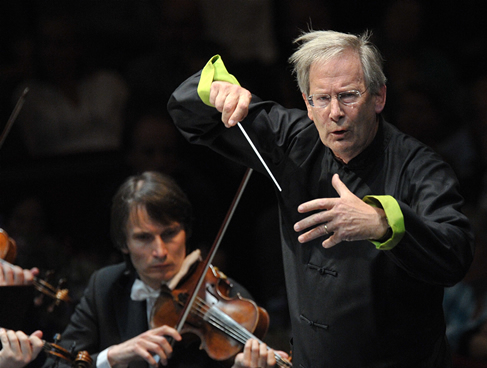Population wise, Chapel Hill is small fry compared with the major east coast cities Washington, D.C., Philadelphia and New York. Yet, all of us who live here know that culturally and artistically we take a back seat to no one. Apparently, major European orchestras know that also as the esteemed Orchestre Révolutionnaire et Romantique, Sir John Eliot Gardiner, music director, chose this university town as the starting point of a four city U.S. tour. If there was any doubt before, Carolina Performing Arts has become an international player, as they presented a two-night Beethoven festival, performed like few of us have ever experienced.
The Orchestre Révolutionnaire et Romantique (ORR) was founded in 1989 by John Eliot Gardiner, who had already garnered great critical and popular acclaim with the English Baroque Soloists. The concept of this and other period-instrument ensembles is to create a performance experience and sound that is close to how these works would have sounded at the time of their creation. This involves scrupulous research of original sources and manuscripts, the use of instruments as they existed at that time, and altered performance techniques – all of which may significantly differ from modern orchestras. While this became a musical growth industry, beginning in the 1970s, the music transformed was nearly all from the Baroque and early Classical period. It took the ORR to press forward a bit in time to the early Romantic period (and even later on to Brahms!) to apply this concept to the Beethoven Symphonies in a landmark recording in the early 1990s. This tour represents the ORR and Gardiner’s return to this repertoire for the first time in nearly twenty years.
There was a feeling in the air at Memorial Hall that we would all be witness to a momentous musical event – and that was before the first note sounded. Like most orchestras, aside from those in the United States, the stage remained empty until all of the musicians filed out together to begin the program. This was a full-sized orchestra with more-or-less the full complement of strings. Since you couldn’t really see all the wind and brass instruments as they came out, everything looked “normal,” except for one unusual feature: there was no podium. Maestro Gardiner strode out, quite majestically, and launched in to the Overture to Egmont. Even in the slow and grave introduction, it was immediately apparent that we were in a world of sound markedly different from your standard, modern orchestra. At this point it was hard to articulate exactly what that difference was, but the energy and this “new” orchestration literally jumped out at you, grabbed your collar, and insisted that you pay attention to every detail of the score. It would get exponentially better.
One of the failings of the original original-instruments movements, later also known as HIP (Historically Informed Performance), was not their musicological scholarship or performances but the perception of arrogance and proselytizing of the practitioners. Gardiner quickly dispelled this stuffy, academic aura as this knighted, very proper, and imposing British gentleman delighted the audience with several lightly educational, perceptive, and quite funny addresses. He briefly described the concept of his orchestra, the state of Europe in the first decade of the 19th century, and Beethoven’s relationship to the events surrounding him. Then we heard his seventh symphony like we have never heard it before.
One of the most notable differences in this historically informed practice is the strict and unbreakable edict that “thou shall not commit vibrato.” One can argue this point till the end of the Mayan calendar, but every string player in the ORR scrupulously observed this practice: there was not one shaking left arm during the entire concert. After looking for reasons why this wouldn’t work for every type of passage, one finally just sat back and enjoyed the pristine intonation, clear and unified sound, and, most of all, the alternative ways the players found to play expressively. Despite this difference, all the string instruments looked like their modern counterparts, which definitely cannot be said about the winds and brass. Wooden flutes, quieter clarinets, oboes, and bassoons gave the woodwinds a closer, more intimate sound. Valveless horns and trumpets were played with such precision that you wondered about the necessity of subsequent “improvements.” One of the most noticeable differences was the timpani. Played on animal skin with hard wooden mallets, the sound canvas ranged from quite murmuring to jump-out-of-your-seat gunshot. Another interesting departure from any orchestra I’ve ever seen or heard is that the timpanist remained seated throughout the performance in a chair like the rest of the ensemble uses.
Now we come to the “da-da-da-daaa” moment. Beethoven’s fifth symphony – particularly the opening motive – is probably the most well-known orchestral work. Gardiner again gave a fascinating talk to the audience about that opening and even demonstrated some passages and instruments. The old-timey contrabassoon – sorry bassoonists, but I imagine you’re used to this – got a huge laugh. This performance of the fifth was a revelation. Parts emerged that you never noticed, dynamics were as integral as the notes, and unusual sounds (to over-saturated modern ears) flew at you from all over the stage. The energy of the playing had you pinned to your seats; it was exhilarating and life-affirming.
Would I want to hear this type of performance practice and early instruments all the time? Probably not, but as an alternative to the deafening repetitiveness and rote performances of many orchestras, it was like being musically reborn. But most of all, regardless of what style was being used these musicians were remarkably focused, engaged, and brilliant in their execution. In both words and demeanor, Gardiner expressed his appreciation for the overwhelming reception he received from two days that will go down as musically epochal in these parts.











